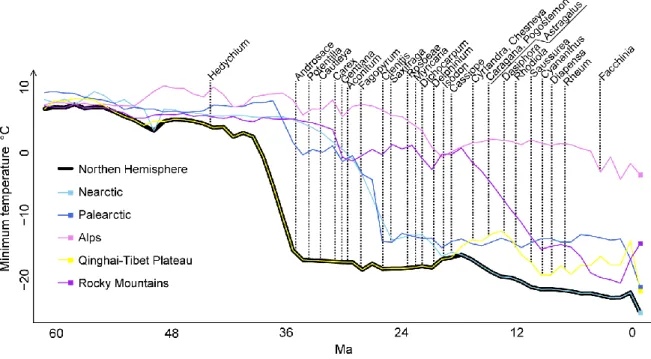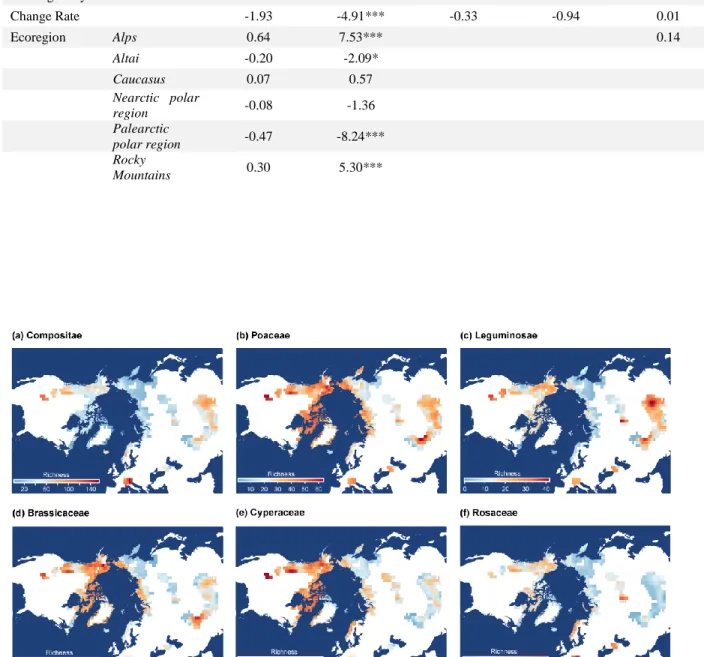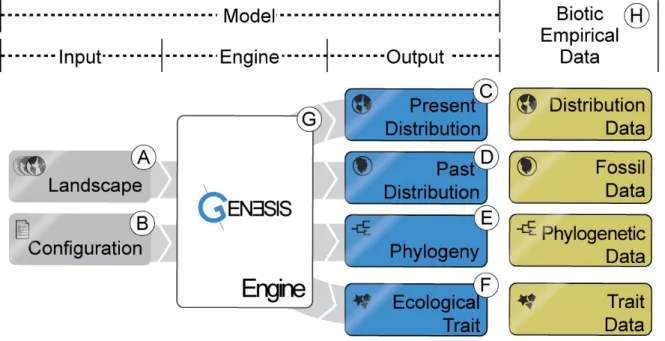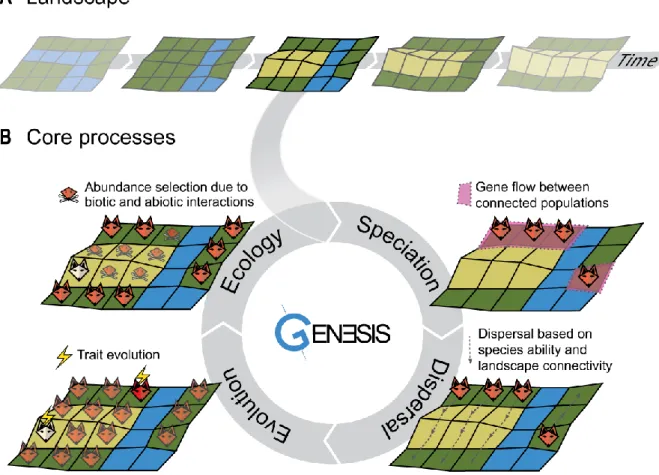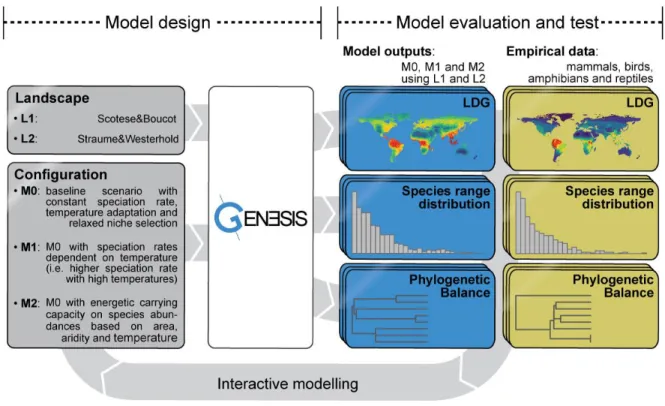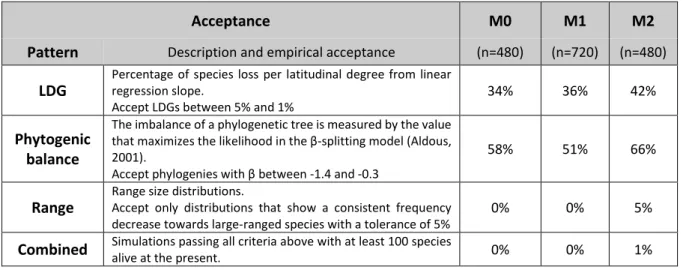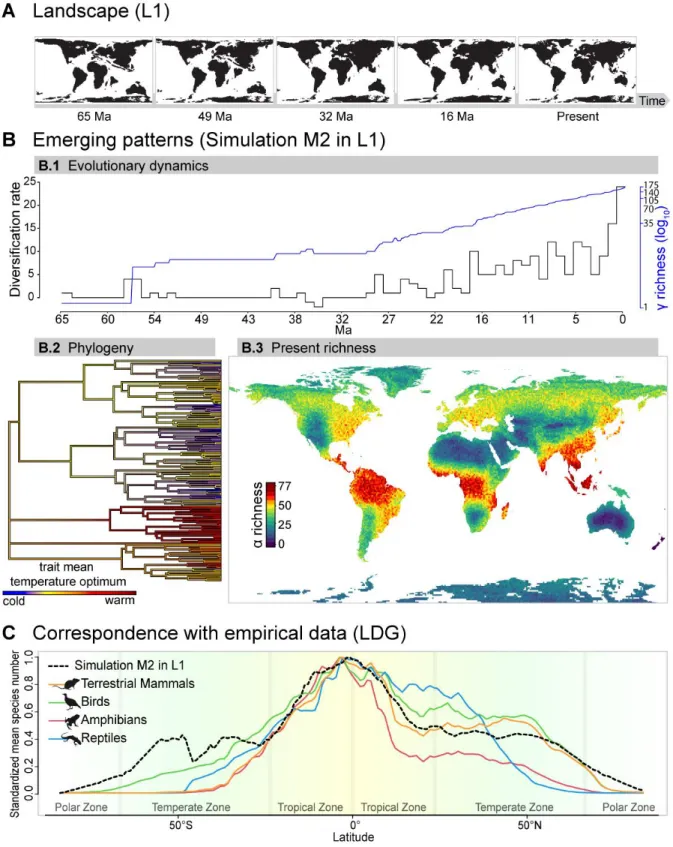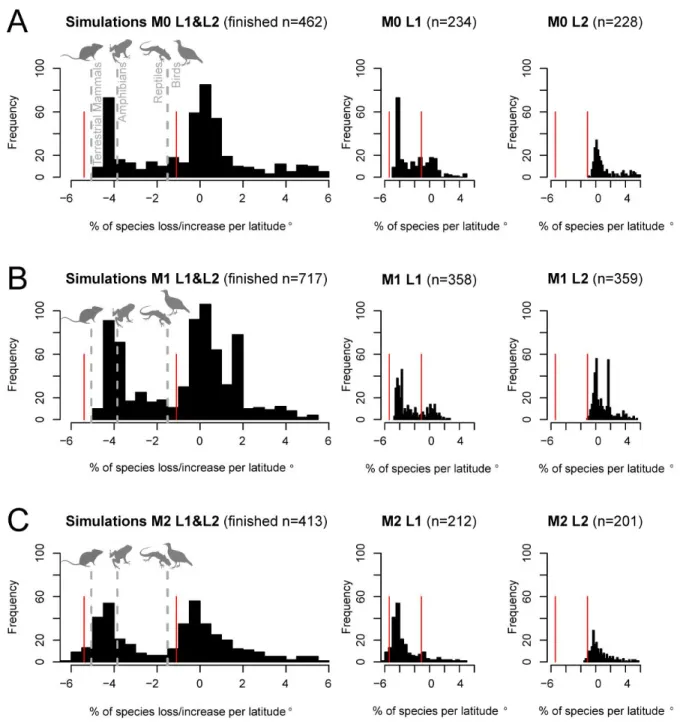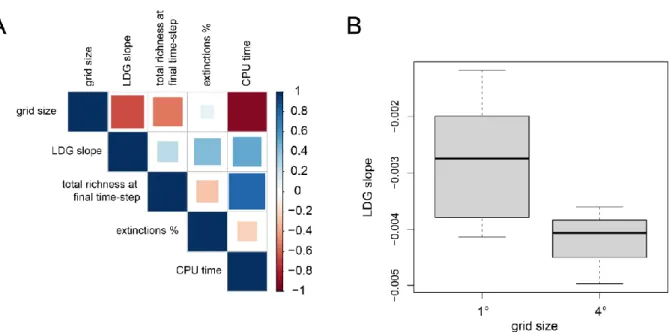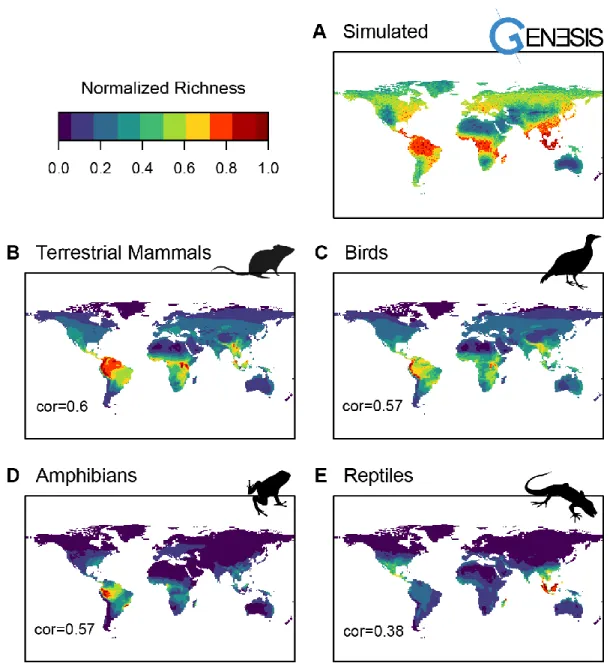Research Collection
Doctoral Thesis
On the Emergence of Biodiversity: Mechanistically Bridging Ecology, Evolution and Paleo-Environments
Author(s):
Hagen, Oskar Publication Date:
2021
Permanent Link:
https://doi.org/10.3929/ethz-b-000477193
Rights / License:
In Copyright - Non-Commercial Use Permitted
This page was generated automatically upon download from the ETH Zurich Research Collection. For more information please consult the Terms of use.
ETH Library
DISS. ETH NO. 27401
ON THE EMERGENCE OF BIODIVERSITY:
MECHANISTICALLY BRIDGING ECOLOGY, EVOLUTION AND PALEO-ENVIRONMENTS
A thesis submitted to attain the degree of DOCTOR OF SCIENCES of ETH ZURICH
(Dr. sc. ETH Zurich)
presented by OSKAR HAGEN
Master of Science ETH in Environmental Sciences, ETH Zürich Born on 03.09.1987
Swiss citizen of Thurgau (FR) and Brazilian
accepted on the recommendation of Prof. Dr. Loïc Pellissier
Dr. Carlos Melian
Prof. Dr. Jens-Christian Svenning Prof. Dr. Niklaus E. Zimmermann
2021
ON THE EMERGENCE OF BIODIVERSITY:
MECHANISTICALLY BRIDGING ECOLOGY, EVOLUTION AND PALEO-ENVIRONMENTS
“Understanding life is not a conquest, but a slow lesson in appreciation.”
Kirschner and Gerhart, 2005, The Plausibility of Life: Resolving Darwin's Dilemma, page xii
TABLE OF CONTENTS
SUMMARY 2
ZUSAMMENFASSUNG 3
GENERAL INTRODUCTION 4
History of naturalism 4
Naturalism and natural laws 4
The theory of evolution 5
Biodiversity 5
Complexity 7
Models 8
Methodological advancements 9
This thesis 10
References 12
CHAPTER ONE 19
Mountain building, climate cooling and the richness of cold-adapted plants in the Northern Hemisphere
Abstract 20
Keywords 20
Introduction 21
Material and methods 24
Reconstruction of orogeny and past climate 24
Meta-analysis of the origin of cold-adapted lineages 24
Data compilation and range mapping 25
Environmental predictors of cold-adapted richness patterns 25
Statistical analyses 26
Results 26
Reconstruction of orogeny and past climate 26
The phylogenetic and phylogeographic evidence for cold-adapted origins 28
Spatial pattern of species richness in cold regions 29
Determinants of cold-adapted species richness 30
Discussion 32
The timing of Northern Hemisphere mountain building and cold climates 32 Drivers of mountain vs. Arctic species diversity imbalance 33 Biogeographical differences between mountain vs. Arctic species richness patterns 33
Limitations 34
Conclusion 35
Acknowledgements 35
Data availability statement 35
References 36
CHAPTER TWO 43
gen3sis: the general engine for eco-evolutionary simulations on the origins of biodiversity
Abstract 44
Keywords 44
Introduction 45
Engine principles and scope 47
Inputs and initialization 48
Landscape 48
Configuration 49
Core functions and objects 49
Speciation. 52
Dispersal 52
Evolution 52
Ecology 53
Outputs and comparisons with empirical data 53
Case study: The emergence of the LDG from environmental changes of the Cenozoic 55
Context 55
Input landscapes 55
Hypothesis implementation 56
Exploration of model parameters 57
Correspondence with empirical data 57
Simulations results and synthesis 58
Discussion 61
Conclusions 64
Acknowledgements 64
Data availability statement 64
References 65
Supporting Information 74
Animations 74
Figures 75
Notes 82
Note S1: The emergence of the LDG from environmental changes of the Cenozoic 82
Paleo reconstructions 82
L1 82
L2 83
Model implementations 84
Speciation 85
Ecology 85
Trait evolution 86
Overview M0, M1 and M2 86
Empirical data 88
Distribution 88
Phylogenies 88
Model Analysis 88
Large-scale biodiversity patterns 90
Modelled to empirical comparisons 90
Spatial resolution 91
High resolution simulations 91
References 91
Note S2: Does trait evolution impact biodiversity dynamics? 95
Experimental design 95
Theoretical Island 95
Computer Model 95
Results and Discussion 96
Perspectives 96
References 97
Note S3: Pseudo-code: gen3sis 98
CHAPTER THREE 99
Earth history events shaped the evolution of biodiversity across tropical rainforests
Abstract 100
Keywords 100
Introduction 101
Results and Discussion 103
Contemporary variation in species diversity and climate between tropical rainforests 103 Paleo-environmental dynamics and macroevolutionary rates in tropical rainforests 105 Paleo-environmental change and the distribution of phylogenetic diversity in tropical
rainforests 110
Conclusion 112
Methods 113
Biodiversity data collection 113
Species diversity and contemporary climate 113
Phylogenetic assemblage structure 114
Paleo-environmental Reconstruction 114
Simulation model and macroevolutionary analysis 115
Acknowledgements 116
References 117
Supporting Information 124
Animations 124
Figures 125
Notes 134
Note S1: Earth history events shaped the evolution of biodiversity across tropical rainforests 134
Paleo-environmental data 134
Paleo-habitat fragmentation analysis 134
References 142
CHAPTER FOUR 143
The rise and fall of cold-adapted floras of the Northern Hemisphere
Abstract 144
Keywords 144
Introduction 145
Results and Discussion 146
The rise 146
The fall 152
Limitations 153
Conclusions 154
Methods 155
Model implementation 155
Paleo-reconstructions 156
Climate change scenarios 157
Data on cold-adapted plants 157
Summary statistics 158
Acknowledgements 158
Data availability statement 158
References 159
Supporting Information 163
Animations 163
Figures 164
Tables 172
GENERAL DISCUSSION 175
History of naturalism 175
Advancements 175
Limitations 177
Paleo-environmental data 177
Distribution, fossil and phylogenetic data 178
Computational time 180
Perspectives 181
Unification of biodiversity theories and hypotheses 181
Unification of Earth and life sciences 183
Retrospections and projections 183
Concluding remarks 185
References 186
ACKNOWLEDGEMENTS 192
CURRICULUM VITAE 193
2
SUMMARY
Understanding the origins of biodiversity has been an aspiration since the days of early naturalists such as Whewell, Lyell, Humboldt, Darwin and Wallace. These pioneers already acknowledged interactions between ecological and evolutionary processes, as well as the roles of continental movements, orogeny and climate variations in shaping biodiversity patterns. As science advanced, the complexity of ecological, evolutionary, geological and climatological processes became evident in an increasingly fragmented scientific landscape. Recent developments in computer modelling now enable the strengthening of interdisciplinary fields, opening unprecedented scientific pathways.
In this thesis, a novel general engine for eco-evolutionary simulations (gen3sis) is presented. The engine consists of a spatially-explicit modelling framework that enables modular implementation of multiple macroecological and macroevolutionary processes interacting across representative spatio- temporally dynamic landscapes. Applications of gen3sis shed light into long-standing enigmas of global biodiversity patterns, such as: the latitudinal diversity gradient (LDG), the pantropical diversity gradient (PDG) and the life history of cold-adapted floras. Multiple reconstructed paleolandscapes and processes (e.g. environmental filtering, biotic interactions, energetic carrying capacities, dispersal, allopatric speciation, and the evolution of stress tolerance and competitive ability) were used to simulate emergent biodiversity patterns (e.g. , and diversity, past and current species ranges, and phylogenies). Conclusions are based on comparisons of simulated patterns with literature reviews and empirical data (i.e. species ranges, phylogenies and fossils) of multiple faunas and floras.
Bridging ecological and evolutionary mechanisms with paleo-environments shaped by plate-tectonic movements, mountain uplifts and deep-time climate changes using gen3sis is shown to be indispensable for reconstructing the formation of many global biodiversity patterns. Energetic carrying capacity was a significant process when concurrently simulating a realistic LDG, species range size frequencies, and phylogenetic tree balance of major tetrapod groups. Differences in paleo- environmental dynamics between continents (e.g. mountain and island formation and habitat fragmentation), combined with weak niche evolution, can explain the PDG by shaping spatial and temporal patterns of species origination and extinction. Simulations matched observed distribution and phylogenetic patterns of tropical plants and animals. Geological and climatological events, combined with species interactions and the evolution of competitive and temperature tolerance traits, provide a remarkable match with observed distributions, fossil records and the phylogenetic nestedness of cold-adapted plants.
This thesis moves beyond correlational approaches and provides a novel framework for formalizing and exploring multiple hypotheses and reconstructions associated with the origin of biodiversity.
Model comparison with empirical data serves hindcast, which might inform biodiversity trajectories.
By advancing our numeric understanding of the physical and biological processes that shape biodiversity, new and interdisciplinary tools such as gen3sis support scientists to piece together key puzzles of the Earth’s astonishing biodiversity.
3
ZUSAMMENFASSUNG
Die Frage nach dem Ursprung und dem Verständnis der Biodiversität beschäftigt Menschen seit früher Zeit. Naturforscher wie Whewell, Lyell, Humboldt, Darwin und Wallace erkannten bereits einige Zusammenhänge zwischen ökologischen und evolutionären Prozessen, Kontinentalbewegungen, Orogenese und Klimaschwankungen und deren Einfluss auf die Biodiversität. Mit fortschreitender Wissenschaft wurde die Komplexität von ökologischen, evolutionären, geologischen und klimatologischen Prozessen ersichtlich. Gleichzeitig spezialisierten und trennten sich die Fächer zunehmend. Jüngste Entwicklungen der Computermodellierung ermöglichen eine bisher beispiellose Vorgehensweise, die einen besseren Überblick und ein vertieftes Verständnis des Ursprungs der Biodiversität fördern kann.
Es wird ein Software-Modell für öko-evolutionäre Simulationen (general engine for eco-evolutionary simulations: gen3sis) vorgestellt. Dieses besteht aus einem räumlich-expliziten Modulierungsgerüst, das die modulare Implementierung mehrerer makroökologischer und makroevolutionärer Prozesse im Zusammenspiel mit repräsentativen, räumlich und zeitlich dynamischen Landschaften ermöglicht.
Mit der Anwendung von gen3sis werden drei bisher unerklärte Fragen globaler Biodiversitätsmuster untersucht: der Latitudinale Biodiversitätsgradient (latitudinal diversity gradient: LDG), die ungleichmässige Biodiversität in tropischen Gebieten (pantropical diversity gradient: PDG) und die Entstehung und Entwicklung von kalt-adaptierten Pflanzen. Zahlreiche Paläolandschaften und Prozesse (z.B. Umweltfilterung, biotische Interaktionen, Tragfähigkeit, Ausbreitung, allopatrische Artenbildung sowie Entwicklung von Stresstoleranz und Wettbewerbsfähigkeit) wurden verwendet, um Biodiversitätsmuster (z.B. - - und -Diversität, historische und aktuelle Artenverbreitungsgebiete und Phylogenien) zu berechnen, welche anschliessend mit verschiedenen Simulationen, Fachliteratur und empirischen Daten (d.h. Artenverbreitungsgebiete, Phylogenien und Fossilien) aus der Tier- und Pflanzenwelt verglichen wurden.
Die Verknüpfung von ökologischen und evolutionären Mechanismen mit Paläolandschaften, welche von plattentektonischen Bewegungen, Gebirgsentwicklungen und langzeitlichen Klimaveränderungen geprägt sind, zeigt sich grundlegend für die Entstehung globaler Biodiversitätsmuster. Die Tragfähigkeit spielte bei Simulation realistischer LDG, Häufigkeit von Artenverbreitungsgebietsgrössen und Ausgewogenheit von phylogenetischen Bäumen bei Tetrapoden eine wesentliche Rolle.
Unterschiede von Paläoumwelt-Dynamiken zwischen Kontinenten (z. B. Gebirgs- und Inselbildung und Habitatfragmentierung) in Kombination mit schwacher Nischenevolution können die ungleichmässige Biodiversität in tropischen Gebieten (PDG) erklären, indem sie räumliche und zeitliche Muster für die Entstehung und das Aussterben von Arten formen. Die durchgeführten Simulationen stimmten mit der beobachteten Verbreitung und den phylogenetischen Mustern tropischer Pflanzen und Tiere überein. Zentrale geologische und klimatologische Ereignisse, gekoppelt mit Interaktionen von Arten und der Entwicklung von Eigenschaften für Wettbewerbsfähigkeit und Temperaturtoleranz, führen zu bemerkenswerten Übereinstimmungen mit der beobachteten Artenverteilung, Fossilien und Phylogenien kalt-adaptierter Pflanzen.
Das vorgestellte Modell geht über herkömmliche Korrelationsansätze hinaus und ermöglicht die Erforschung weiterer Hypothesen und Rekonstruktionen im Zusammenhang mit dem Ursprung und der Entwicklung von Biodiversität. Der Vergleich des Modells mit empirischen Daten erlaubt nachträgliche Berechnungen sowie zukunftsbezogene Entwicklungsszenarien der Biodiversität. Neue und interdisziplinäre Modelle wie Gen3sis verstärken das Verständnis von physikalischen und biologischen Prozessen, welche die Biodiversität prägen.
4
GENERAL INTRODUCTION
History of naturalism
Observing nature has been a constant source of enquiries and wonder for humans. Specifically, the diversity of life forms and their manifestations though time and space have fascinated scientists for centuries. Debates about the origins of the diversity of lifeforms, or biodiversity (Wilson, 1988), are ongoing. In this thesis, ecological, evolutionary and paleo-environmental knowledge are bridged in the pursuit of new insights on the emergence of biodiversity, and a new tool for biodiversity research is introduced.
Naturalism and natural laws
Initially the laws of nature were seen as the laws of the supernatural, but gradually philosophers and naturalists tended to rejected theistic causes and looked for other explanations (Okasha, 2002). During the 17th century, scientists started addressing these questions with more objective methodologies, including observations and experiments, and through the institutionalization of research. The Enlightenment during the 18th century, with its strong antireligious and materialistic trends, shaped the scientific enterprise (Holmes, 1997). During the 20th century, logical empiricism dominated the philosophy of science and scientists searched for fundamental theoretical principles explaining the
“laws of nature”, with physics at the central stage (Okasha, 2002).
This search for laws was the domain of natural philosophy, while natural history was constrained to ordering living organisms without a causal understanding. Darwin called himself a “philosophical naturalist” and this interdisciplinary position was certainly of importance in his thinking (Hodge and Radick, 2003, Sloan, 2003). Newton’s law of universal gravitation was a first great unification (Newton, 1729). However, while such theories provide a solid understanding when observing natural phenomena, the biological world poses obstacles in finding such laws (Okasha, 2002). One reason for this is the multitude of empirical facts that are explained by a similarly large number of hypotheses in the biological realm (Pontarp et al., 2019b). Nature’s often nonlinear processes and complexity of biological phenomena add additional difficulty in observation and in the development of causal approximations. Therefore, the scientific logical linear empiricist conception of the 20th century hindered a better grasp of biological phenomena (Okasha, 2002).
Driven by the observation of fossils, William Whewell (1794–1866) proposed the creation of a new type of science called “palaetiological sciences”, forcing the temporal dimension into a new, less descriptive discipline (Whewell, 1847). Friedrich W.H. Alexander von Humboldt (1769–1859) was a travelling naturalist who collected data and specimens from mountain ranges to formulate a general theory of nature in which the characteristics of mountains influence their floras (Humboldt and Bonpland, 1807). Humboldt’s vision, formed in the context of German romanticism, encompassed a fully connected natural system, where geological and biological mechanisms are strongly intertwined (Wulf, 2015). Therefore, in Charles R. Darwin’s time (1809–1882), a created and unchangeable world was already under suspicion (Glass et al., 1968). Charles Lyell (1797–1875), another inspiration for Darwin, claimed that constant gradual changes, acting over a long period of time and still occurring in the present, are the reason for geological changes (Howard, 2001). The concept of fixedness of species was similarly difficult to maintain in the face of observational data and was criticized, sometimes in ambiguous ways as in the writings of Linnaeus, Robinet and Buffon (Bowler, 2009).
The ideas of William C. Wells (1757–1817), Patrick Matthew (1790–1874), Robert E. Grant (1793 – 1874), Charles Lyell (1797–1875), Alfred R. Wallace (1823–1913), Herbert H. Smith (1851–1919) and many others (Dawkins, 2010) were a fecund ground for the development of Darwin’s theory (Glass et
5 al., 1968). Darwin’s theory links existing biological species in the past through a common ancestor, implying therefore a common history of all living creatures (Darwin, 1859). Darwin’s book was written at the perfect time, in a comprehensible and elaborated rhetorical style that woke up the public and engendered a scientific revolution by Kuhn’s definition (Dawkins, 2010). Darwin´s revolutionary book encompassed general facts of nature and theoretical hypotheses justifiable through their consequences, plausibly explaining many aspects of our world (Gayon, 2003).
The theory of evolution
The theory of evolution still holds an unique place in modern biology, as its heuristical power brings order to a multitude of empirical observations (Gayon, 2003). As famously stated: “Nothing in biology makes sense except in the light of evolution” (Dobzhansky, 1973). Evolutionary theory provides a unique type of understanding (Gayon, 2003). It forms the framework of many biological questions, even if they focus on the present. Moreover, it allows us to move from proximate questions (how does a particular process work?) to ultimate questions (why do we observe certain phenomena?) (Okasha, 2002). This is mostly done by investigating the evolutionary advantages and the conditions natural selection has acted upon over time, shaping the world we experience. This makes the theory of evolution a powerful tool to explain and explore the current living world as a logical response to the past and present environment. The main pillars of Darwin’s theory are: (i) new characteristics of species or populations evolve over time; (ii) all species have a common ancestor; and (iii) natural selection is the driving force of evolution. Evolution gives rise to distinct patterns of diversity in living organisms across the globe (Darwin, 1859).
Jean-Baptiste Lamarck (1744–1829), like Darwin, believed that a species was not a stable unity, but changed over time (Ghiselin, 1994). While Lamark focused on individual changes, Darwin’s focus was on the population level (Mayr, 1994).. As expressed by Richard Lewontin, Larmark’s theory is transformational, while Darwin’s theory is variational. Darwin’s theory brought a new way of thinking, mainly “population thinking”, by explaining facts through the changes occurring between and within populations (Mayr, 1994). Treating the population as the relevant unit of analysis makes a conceptual shift and recognizes individuals and populations as units of study in their own right. Even with a growing knowledge about the complexity and mechanisms involved in observed diversity, Darwin’s theory still holds and will in the future (Okasha, 2002). The overwhelming evidence in favour of evolution leaves little space for doubt, and its power to explain is reason enough to maintain it. During the 20th century, the biological sciences underwent several advancements, in particular the discovery of DNA by James Watson and Francis Crick in 1953. The integration of Darwin’s theory with genetics in the early 20th century gave rise to Neo-Darwinism, which states that random mutations and natural selection are the drivers of evolutionary change (Gayon, 2003). These ideas are central to our current understanding of biodiversity (Dawkins, 2010).
Biodiversity
Biodiversity has many facets and can be better grasped as a set of measurements, evading a single definition (Gaston and Spicer, 2004). A pluralist approach allows the application of different measurements in multiple contexts without threatening the objective assessment of biodiversity (Barrotta and Gronda, 2020). Biodiversity metrics may include genetic, phylogenetic, functional and multi-level taxonomic concepts, as well as occurrences across spatial scales (e.g. alpha-, beta- and gamma-diversity). Moreover, species abundances can also be considered when measuring diversity (Shannon, 1948). Finally, species richness, a commonly used biodiversity measurement (Benton, 2016), is defined as the number of different species in a certain site, region or community. Species richness is unevenly distributed and varies across continents (Pellissier et al., 2014, Couvreur, 2015)
6 and along spatial and environmental gradients (Gaston, 2000, Jetz et al., 2012), such as latitude (Mittelbach et al., 2007, Fine, 2015).
Numerous hypotheses to explain the emergence and unevenness of biodiversity have been formulated (e.g. Darwin, 1859, Hutchinson, 1959, MacArthur, 1965, Pianka, 1966, MacArthur and Wilson, 1967, Willig et al., 2003, Mittelbach et al., 2007, Pellissier et al., 2014, Fine, 2015, Schemske and Mittelbach, 2017). Currently, it is widely accepted that ecological interactions influence species distributions and thus biodiversity patterns (Broennimann et al., 2012). Moreover, these biodiversity patterns are shaped by migration and differences in the intensity of historical speciation and/or extinction events (Svenning et al., 2015), which are all dependent on the evolutionary and ecological context (Pontarp et al., 2019b). Although this thesis addresses multiple biodiversity contrasts, only two of them will be addressed here:
Cold regions. Contrasts in diversity across cold regions, with alpine areas being frequently floristically richer than similar arctic areas, are still a puzzle (Tolmachev, 1960, Hultén, 1962, Billings, 1973, Murray, 1995). Scientist have attributed this pattern to differences in summer heat, habitat diversity, relative age, and glacial history (Billings, 1973), as well as to the colonization of the Arctic by lineages that originated in mid-latitude mountain ranges (Tolmachev, 1960, Hultén, 1962, Murray, 1995). The occurrence of similar species across cold regions suggests frequent biotic exchanges (Tolmachev, 1960, Tkach et al., 2008). Moreover, the origin of cold-adapted plant lineages may have preceded the arrival of cold climates in the Arctic, and it may be associated with orogenic processes and mountain building during the progressive global cooling during the Oligocene-Miocene (Sun et al., 2017).
Modern phylogenetic and biogeographic studies (Antonelli et al., 2009, Hoorn et al., 2010) reinforce the link between orogeny and plant diversification in specific mountain ranges (Hughes and Eastwood, 2006, Antonelli et al., 2009).
Tropical regions. While tropical rainforests are the world’s most species-rich terrestrial biomes (Gentry, 1992), the total regional diversity and number of species that co-exist locally varies dramatically across continents (Couvreur, 2015). The relatively species-poor Afro-tropics has therefore been labelled as the “odd one out” (Richards, 1973). Tropical angiosperm richness has been shown to be limited by precipitation (Parmentier et al., 2007) and the lack of extremely high precipitation in the Afro-tropics has been suggested to have contributed to its reduced richness (Richards, 1973). Historical explanations for tropical rainforest diversity, on the other hand, emphasize the role of paleo-environmental dynamics in present-day species diversity (Hoorn et al., 2010, Antonelli et al., 2018, Couvreur et al., 2020). Paleo-environmental changes over deep time have meant that the different tropical regions of the world have had dramatically different geological and climatic histories influencing macroevolutionary dynamics (Gaston, 2000). Both mountain uplift and island formation, in connection with changes in climate, led to variation in diversification rates (Quintero and Wiens, 2013, Huppert et al., 2020), most likely influencing regional diversity patterns in tropical rainforests (Couvreur et al., 2020). The primacy of this mechanism is still debated (Harmon and Harrison, 2015, Rabosky and Hurlbert, 2015), partly because many of the features that have been shown to correlate with species richness, such as productivity and precipitation, also co-vary with other environmental features that might drive patterns of species diversity, such as mountain uplift and historical environmental stability, making it difficult to distinguish between alternative explanations.
7
Complexity
Explanations for the main principles underlying the emergence of biodiversity are frequently proposed but are rarely quantified or readily generalized across study systems (Pontarp et al., 2019b). Multiple processes that act and interact with different strengths across spatio-temporal scales still pose obstacles to deciphering biodiversity dynamics (Pontarp et al., 2019b). Current research suggests that allopatric (Leprieur et al., 2016) and ecological (Doebeli and Dieckmann, 2003) speciation, dispersal (Duputie and Massol, 2013) and adaptation (Keller and Seehausen, 2012) all act and interact simultaneously within the surrounding environment (Urban, 2011, Mittelbach and Schemske, 2015) to produce observed biodiversity patterns (Schluter and Pennell, 2017). Comprehensive explanations of the origin and dynamics of biodiversity must therefore consider a large number of mechanisms and their feedbacks, including ecological and evolutionary responses to the dynamic abiotic environment, acting on multiple time-scales (Leidinger and Cabral, 2017, Pontarp et al., 2019b).
Past events are hypothesized to have influenced regional diversity by connecting different communities during mountain uplift (Quintero and Jetz, 2018) and island formation (Huppert et al., 2020), which – in association with climatic variations – altered diversification rates (Jansson and Davies, 2008, Svenning et al., 2015). During the last ~100 myr, when many extant clades diversified, the position of the continents, their topography and climatic conditions changed, staging multiple biodiversity dynamics (Leprieur et al., 2016). In Asia, for example, the collision of continental plates, such as Sundaland and Australia in the Eocene and India and Asia in the Miocene, increased diversity by connecting distinct communities of various species while forming new mountain and island systems (Richards, 1973, Crayn et al., 2015). In South America, the Andean uplift resulted in increased habitat heterogeneity and fragmentation, boosting diversification (Hoorn et al., 2010). Dobzhansky (1950) proposed that stable tropical climates over ecological or geological time-scales favour greater specialization, promoting divergent selection along ecological axes. For instance, Australia started a northward motion towards Asia, crossing through the temperate and subtropical latitudes. This movement caused strong changes in climate (Hall, 1998), which ultimately reduced species diversity (Byrne et al., 2011). In contrast, biodiversity hotspots in the tropics are thought to result from greater historical environmental stability, consequently decreasing the risk of extinction (Dynesius and Jansson, 2000) and increasing speciation (Weir and Schluter, 2007).
Under different historical conditions, ecological and evolutionary processes may result in different biodiversity patterns, since functional traits that potentially condition eco-evolutionary processes influence species co-existence and their likelihood of speciation (Hubert et al., 2015). Traits are measurable characteristics that reflect and shape evolutionary history (Darwin, 1859). Natural selection promotes the evolution of traits that optimize species survival under specific environmental conditions. Good examples of such traits are tree height and seed size of tropical South-East Asian Dipterocarpaceae. Ashton (1969) proposed that these traits entailed both an ecological advantage over competitors and evolutionary consequences by promoting geographical isolation and local adaptation. Dispersal ability illustrates how ecological and evolutionary histories can be linked. For example, in areas with higher environmental fluctuations, high dispersal ability allows rapid species colonization after perturbations and thus potentially prevents extinction. Moreover, dispersal ability also influences speciation by modulating gene flow among populations (Riginos et al., 2014). Through gene flow, dispersal further controls the effective size of populations (Wright, 1946) and, as predicted by the nearly neutral theory of molecular evolution, a decrease in effective population size leads to easier fixation of mutations (Ohta, 1992). Dispersal, therefore, has the compound role of modulating species co-existence in meta-communities, the likelihood of speciation, and the evolution of functional
8 traits. Hence, traits that mediate species co-existence in meta-communities may also influence speciation and evolution, which could feed back to shape community assembly (Donati et al., 2019).
In the light of this high complexity, biodiversity contrasts can rarely be explained by a single theory or process (Pontarp and Wiens, 2017, Pontarp et al., 2019b). Multiple arrangements of parts that result in a complex set of effects in a system are defined as a mechanism (Dawkins, 2010). Although a multitude of factors challenge the recognition of the mechanisms responsible for Earth’s biodiversity manifestations, progress has been made throughout history. Previous approaches, which typically inferred about historical processes by applying correlations between present-day diversity and proxies of diversification rates or evolutionary time, often did not address local patterns of species co- occurrences (Field et al., 2009, Sandel et al., 2011, Marin, 2016). Ecologists and evolutionary biologists have attempted to test and disentangle these hypotheses, for example via phylogenetic diversification analysis (Morlon et al., 2011, Faurby et al., 2016). Phylogenetic methods offer an alternative tool for
“time travelling” by looking at diversification rates of clades across regions (Tonini et al., 2016, Eiserhardt et al., 2017, Upham et al., 2019, Dagallier et al., 2020) but might be strongly biased, as they lack genetic and fossil data, for example, and rarely address spatial aspects (Hagen et al., 2018, Silvestro et al., 2018, Coiro et al., 2019). Although fossil analysis provides powerful insights on how Earth’s biodiversity has changed over time, it also involves many biases when macroevolutionary processes are inferred from them (Coiro et al., 2019). Making inferences about historical processes is restricted by the absence of well-sampled fossil data for most groups and poor paleo-environmental coverage. Moreover, the common approaches listed above lack the ability to explore the entire ensemble of ecological and evolutionary mechanisms interacting with dynamic landscapes, which possibly drives contemporary patterns (Rohde, 1992, Willig et al., 2003, Gotelli et al., 2009, Pontarp et al., 2019b).
Models
In order to study biological systems, biologists build models that are based on a set of hypothetical assumptions which ideally are empirically proven. These assumptions can be seen as “natural laws” if they are spatio-temporally unrestricted generalizations with a certain degree of resilience, i.e. hold across multiple cases (Godfrey-Smith, 2014). To work out consequences of multiple assumptions, computers are powerful scientific tools. In computer models, our current knowledge and beliefs are formalized and then tested with mathematical rigour and objectivity, strongly aiding the scientific enterprise (Godfrey-Smith, 2014). Beyond providing historical archives of belief and knowledge, model outputs can be compared with empirical data, providing insights on natural mechanisms if resilience is present and maintained across space and time.
In contrast to backward investigations based on observations, forward analyses with computer models aim to reproduce present biological patterns from a starting point, using fundamental processes to build up diversity over time (Pontarp et al., 2019b). Thus, process-based modelling offers a unique tool to explore the eco-evolutionary mechanisms behind the origins of biodiversity patterns in silico (Gotelli et al., 2009). By combining paleo-environmental reconstructions with knowledge of current eco-evolutionary processes and contrasting these with multiple empirical observations (Pontarp et al., 2019b), process-based models can consider the interplay of macroevolutionary dynamics, including speciation and extinction (Rangel et al., 2018, Donati et al., 2019, Saupe et al., 2019b, Saupe et al., 2020). Pursuing a mechanistic and multipurpose approach to macroevolutionary analysis is a promising perspective (Pontarp et al., 2019b). Other research fields, such as climatology (Simpkins, 2017) and cosmology (Vogelsberger et al., 2020), have already demonstrated that progress can be made using computer models of complex systems, especially when in-situ experiments or analytical
9 evaluation are not feasible. Computer models can play out the consequences of complex interacting processes in a dynamic environment and thus are suitable to study the emergence of biodiversity.
Several case studies have illustrated the feasibility and usefulness of such an approach (Leprieur et al., 2016, Tittensor and Worm, 2016, Rangel et al., 2018, Cabral et al., 2019a, Cabral et al., 2019b, Saupe et al., 2019b, Skeels and Cardillo, 2019, Saupe et al., 2020). For example, eco-evolutionary models have reproduced empirical patterns of the formation of biodiversity associated with latitude (Tittensor and Worm, 2016, Gaboriau et al., 2019, Saupe et al., 2019a, Saupe et al., 2019b), climate and geological dynamics (Leprieur et al., 2016, Rangel et al., 2018, Saupe et al., 2020), and reproductive isolation by dispersal ability and geographic distance (Cabral et al., 2019a). Using deep-time paleo- reconstructions, Leprieur et al. (2016) predicted realistic biodiversity patterns while ignoring species interactions and the evolution of traits. Using a similar model also for deep time, Donati et al. (2019) found spatial congruence between modelled dispersal ability and species traits linked with mobility while ignoring more complex species interactions. In a much shorter time-scale reconstruction, Saupe et al. (2019b) revealed spatio-temporal climate change contributions to the latitudinal diversity gradients by deploying a simple model that considers dispersal and niche breadth while ignoring biotic interactions and niche evolution. Also over a smaller time-scale, i.e. 800 kyr, Rangel et al. (2018) predicted realistic species richness for South America, while considering adaptation, geographical range shifts, range fragmentation, speciation, long-distance dispersal and competition between species. Excluding the above-mentioned exceptions, previous spatial diversification models are generally neutral (Rosindell et al., 2010, Leprieur et al., 2016, Donati et al., 2019) and do not integrate eco-evolutionary feedbacks, functional trade-offs or trait evolution in a flexible and modular way.
Most macro-eco-evolutionary models implement, and thus test, a limited set of evolutionary processes and hypotheses, constraining interpretations to the considered model mechanisms. Model predictions are sensitive to the selection of multiple biological processes, as well as the properties of the dynamic landscape upon which biological processes act. Moreover, the explored systems are often fixed in space, from a global (Leprieur et al., 2016, Saupe et al., 2019b) to continental (Rangel et al., 2018) or regional scale (Cabral et al., 2019a, Cabral et al., 2019b), and in time, from millions of years (Cabral et al., 2019a, Cabral et al., 2019b, Gaboriau et al., 2019) to only a few thousand years (Saupe et al., 2019b). The different input and output formats, as well as various algorithmic implementations, reduce interoperability between hitherto available models. Ideally, biological theories, hypotheses and environmental reconstructions would be compared within a common and standardized platform with the flexibility and modularity required for multiple processes and the possibility to include a variety of landscape scenarios (Gotelli et al., 2009). Additionally, the availability of model code only upon request hinders transparency and reproducibility. The code for current eco-evolutionary population models (Rangel and Diniz-Filho, 2005, Rangel et al., 2007, Gotelli et al., 2009, Pigot et al., 2010, Kubisch et al., 2014, Leprieur et al., 2016, Sukumaran et al., 2016, Cabral et al., 2019a, Pontarp et al., 2019a, Saupe et al., 2019a, Saupe et al., 2019b, Saupe et al., 2020) is only available upon request and was not designed to be user friendly or flexible regarding the inclusion of multiple eco- evolutionary rules.
Methodological advancements
Increased generality is a desirable feature of future models that are created to explore the processes and landscapes that shape biodiversity in dynamic systems, from rivers (Muneepeerakul et al., 2019) to islands (Jõks and Pärtel, 2018, Cabral et al., 2019a, Cabral et al., 2019b) and mountains (Xu et al., 2018), and across gradients such as latitude (Gaboriau et al., 2019, Pontarp et al., 2019b, Saupe et al., 2019b). A decade after the seminal paper by Gotelli et al. (2009), repeated calls have been made for a broader use of mechanistic simulation models in biodiversity research to improve our understanding
10 of the processes driving the origin of biodiversity (Cabral et al., 2017, Connolly et al., 2017, Pontarp et al., 2019b). Practical implementations and answers to these calls have yet to be consolidated and widely tested. To this day, a mechanistic understanding of ecological, evolutionary and geodynamic spatial processes driving diversity patterns remains elusive (Etienne et al., 2019, Pontarp et al., 2019b).
The complexity of interacting ecological, evolutionary and spatial processes still limits our ability to propose, test and apply mechanisms underlying the emergence of biodiversity patterns (Doebeli and Dieckmann, 2003).
A general model of biodiversity should integrate eco-evolutionary feedbacks with paleo- environmental fluctuations. In previous studies, the consequences of historical environmental changes on current biodiversity were examined using correlative approaches (Sandel et al., 2011, Pellissier et al., 2014). However, correlative approaches do not provide a mechanistic understanding of the way in which historical processes have shaped biodiversity (Gotelli et al., 2009). One major issue is that past environmental fluctuations are often spatially confounded with current environmental conditions, a relationship that correlative approaches are unable to disentangle. Other biological models, such as Dynamic Vegetation Models, were developed to map the distribution of major biomes associated with ancient climates (e.g. Sepulchre et al., 2006). As they consider unbreakable vegetation units, such models cannot address general questions related to the emergence of biodiversity. Based on reconstructed paleohabitats, spatial diversification models should track the distribution of lineages, as well as their genealogy, which can be compared with empirical evidence (Gotelli et al., 2009, Pontarp et al., 2019b). There is a pressing need for a new generation of biodiversity models that explicitly integrate species diversification within the historical sequence of environmental conditions (Gotelli et al., 2009).
This thesis
In order to shed light on the mechanics behind Earth’s biodiversity, I propose an integrative hypothesis-driven process-based approach in order to understand biodiversity dynamics. Rather than providing ultimate answers, this work should be seen as a step forward, shedding light on new ways of bridging ecology, evolution, paleobiology and paleo-environmental science in order to understand the emergence of biodiversity gradients. Along with the technical advancements proposed in this work, I expect that the novel model engine will allow researchers to: (i) quantify distinct processes shaping biodiversity; (ii) test and create new eco-evolutionary hypotheses; (iii) formalize present knowledge, i.e. by formulating mathematical and computational functions; and (iv) ultimately allow eco-evolutionary projections and retrospections. Moreover, this model is of potential use to other fields, including some currently not relying on natural processes.
This work consists of four chapters:
Chapter One. I present a correlational approach to explore the origin of cold-adapted floras and the role of paleo-environmental dynamics in the richness of cold-adapted vascular plant species. This work was heavily dependent on the gathering of empirical knowledge on species distributions, and phylogenies, as well as paleo-environmental reconstructions. Findings support the hypothesis that the orogeny and progressive cooling in the Oligocene‐Miocene generated cold climates in mid‐latitude mountain ranges before the appearance of cold climates in most of the Arctic. A considerable amount of evidence indicates that evolution and diversification of cold-adapted plant lineages occurred in early cold mountainous regions, followed by the colonization of the Arctic.
Chapter Two. I present gen3sis, a modelling engine that addresses many of the named issues and offers the possibility to explore the eco-evolutionary dynamics of lineages under a broad range of biological processes and landscapes. Prioritizing theoretical correctness of the predicted response
11 over precision in terms of possible natural processes, a spatio-temporal mechanistic model was created in the most flexible way possible in order to explore multiple hypotheses and processes. The model simulates populations and is based on the theory of evolution, as well as other first principles in ecology and evolution. The model is showcased by solving long standing questions, i.e. the mechanisms necessary for the creation of the latitudinal diversity gradient and the role of spatio- temporal dynamics in species diversity.
Chapter Three. I apply gen3sis to investigate the uneven distribution of species richness amongst tropical regions of the globe. Ever since the early voyages of renowned explorers, such as Humboldt, Darwin and Wallace, the outstanding species richness found in the Neotropics remained a puzzle in our understanding of the evolution of life on Earth. A history of in-situ diversification is expected to lead to regions with many closely related species and therefore strongly clustered phylogenetic diversity, while a history of either extinction or dispersal is likely to decrease the net relatedness of species assemblages (Kissling et al., 2012). Dissecting the speciation and extinction rates in the proposed mechanistic model can help us to understand how the dynamic interplay of macroevolutionary processes with paleo-environmental dynamics has shaped the distribution of tropical biodiversity. The ubiquity of the pantropical diversity gradient across more than 150,000 species of terrestrial plants and vertebrates is investigated for the relationship between present-day climate and patterns of species richness. Consequences of paleo-environmental dynamics on the emergence of biodiversity gradients are calculated using the novel modelling engine.
Chapter Four. I revisit the cold-adapted species empirical patterns from Chapter One, this time equipped with paleo-environmental reconstructions and a mechanistic model engine to shed light onto the mechanisms behind cold-adapted plant richness and possible cold-adapted flora future under threat as a result of climate change. I use gen3sis to model ecological, evolutionary, geological and climatological first principles coupled with topo-climatic reconstructions for the Cenozoic (last 55 myr). To validate when and where cold-adapted plants first appeared, evolved and coped with climatic change, I compare simulations to empirical data of species ranges, phylogenies and fossils. I demonstrate how paleohabitats played a crucial role, in tandem with species dispersal ability and adaptation potential, to shape current species patterns and how this knowledge can be used for assessments of biodiversity threats.
12
References
Antonelli A., Nylander J.A., Persson C., Sanmartín I. (2009). Tracing the impact of the andean uplift on neotropical plant evolution. Proceedings of the National Academy of Sciences 106:9749-9754.
Antonelli A., Zizka A., Carvalho F.A., Scharn R., Bacon C.D., Silvestro D., Condamine F.L. (2018).
Amazonia is the primary source of neotropical biodiversity. Proceedings of the National Academy of Sciences 115:6034-6039, doi:10.1073/pnas.1713819115.
Ashton P.S. (1969). Speciation among tropical forest trees: Some deductions in the light of recent evidence. Biological Journal of the Linnean Society 1:155-196.
Barrotta P., Gronda R. (2020). What is the measning of biodiversity? A pragmatist approach to an intrinsically interdisciplynary concept. Controversies (cvs),. Amsterdam ; Philadelphia, John Benjamins Publishing Company, p. 115.
Benton M.J. (2016). Origins of biodiversity. PLoS Biology 14:e2000724, doi:10.1371/journal.pbio.2000724.
Billings W. (1973). Arctic and alpine vegetations: Similarities, differences, and susceptibility to disturbance. Bioscience 23:697-704.
Bowler P.J. (2009). Evolution the history of an idea. 25th anniversary ed. Berkeley, University of California Press.
Broennimann O., Fitzpatrick M.C., Pearman P.B., Petitpierre B., Pellissier L., Yoccoz N.G., Thuiller W., Fortin M.-J., Randin C., Zimmermann N.E., Graham C.H., Guisan A. (2012). Measuring ecological niche overlap from occurrence and spatial environmental data. Global Ecology and Biogeography 21:481-497, doi:10.1111/j.1466-8238.2011.00698.x.
Byrne M., Steane D.A., Joseph L., Yeates D.K., Jordan G.J., Crayn D., Aplin K., Cantrill D.J., Cook L.G., Crisp M.D., Keogh J.S., Melville J., Moritz C., Porch N., Sniderman J.M.K., Sunnucks P., Weston P.H. (2011). Decline of a biome: Evolution, contraction, fragmentation, extinction and invasion of the australian mesic zone biota. Journal of Biogeography 38:1635-1656, doi:10.1111/j.1365-2699.2011.02535.x.
Cabral J.S., Valente L., Hartig F. (2017). Mechanistic simulation models in macroecology and biogeography: State-of-art and prospects. Ecography 40:267-280, doi:10.1111/ecog.02480.
Cabral J.S., Whittaker R.J., Wiegand K., Kreft H., Emerson B. (2019a). Assessing predicted isolation effects from the general dynamic model of island biogeography with an eco‐evolutionary model for plants. Journal of Biogeography, doi:10.1111/jbi.13603.
Cabral J.S., Wiegand K., Kreft H. (2019b). Interactions between ecological, evolutionary and environmental processes unveil complex dynamics of insular plant diversity. Journal of Biogeography, doi:10.1111/jbi.13606.
Coiro M., Doyle J.A., Hilton J. (2019). How deep is the conflict between molecular and fossil evidence on the age of angiosperms? New Phytologist 223:83-99, doi:10.1111/nph.15708.
Connolly S.R., Keith S.A., Colwell R.K., Rahbek C. (2017). Process, mechanism, and modeling in macroecology. Trends in Ecology and Evolution 32:835-844, doi:10.1016/j.tree.2017.08.011.
Couvreur T.L.P. (2015). Odd man out: Why are there fewer plant species in african rain forests? Plant Systematics and Evolution 301:1299-1313, doi:10.1007/s00606-014-1180-z.
Couvreur T.L.P., Dauby G., Blach-Overgaard A., Deblauwe V., Dessein S., Droissart V., Hardy O.J., Harris D.J., Janssens S.B., Ley A.C., Mackinder B.A., Sonke B., Sosef M.S.M., Stevart T., Svenning J.C., Wieringa J.J., Faye A., Missoup A.D., Tolley K.A., Nicolas V., Ntie S., Fluteau F., Robin C., Guillocheau F., Barboni D., Sepulchre P. (2020). Tectonics, climate and the diversification of the tropical african terrestrial flora and fauna. Biological Reviews Cambridge Philosophical Society, doi:10.1111/brv.12644.
Crayn D.M., Costion C., Harrington M.G., Richardson J. (2015). The sahul-sunda floristic exchange:
Dated molecular phylogenies document cenozoic intercontinental dispersal dynamics. Journal of Biogeography 42:11-24, doi:10.1111/jbi.12405.
Dagallier L.M.J., Janssens S.B., Dauby G., Blach-Overgaard A., Mackinder B.A., Droissart V., Svenning J.C., Sosef M.S.M., Stevart T., Harris D.J., Sonke B., Wieringa J.J., Hardy O.J., Couvreur T.L.P.
13 (2020). Cradles and museums of generic plant diversity across tropical africa. New Phytologist 225:2196-2213, doi:10.1111/nph.16293.
Darwin C. (1859). On the origin of species by means of natural selection, or preservation of favoured races in the struggle for life. London, John Murray.
Dawkins R. (2010). Darwins five bridges: The way to natural selection. In: Bryson B, Turney J editors.
Seeing further : The story of science, discovery, and the genius of the royal society. New York, NY, William Morrow.
Dobzhansky T. (1950). Evolution in the tropics. American Scientist 38:209-221.
Dobzhansky T. (1973). Nothing in biology makes sense except in the light of evolution. The American Biology Teacher 35:125-129.
Doebeli M., Dieckmann U. (2003). Speciation along environmental gradients. Nature 421:259-264, doi:10.1038/nature01274.
Donati G.F.A., Parravicini V., Leprieur F., Hagen O., Gaboriau T., Heine C., Kulbicki M., Rolland J., Salamin N., Albouy C., Pellissier L. (2019). A process‐based model supports an association between dispersal and the prevalence of species traits in tropical reef fish assemblages.
Ecography 42:2095-2106, doi:10.1111/ecog.04537.
Duputie A., Massol F. (2013). An empiricist's guide to theoretical predictions on the evolution of dispersal. Interface Focus 3:20130028, doi:10.1098/rsfs.2013.0028.
Dynesius M., Jansson R. (2000). Evolutionary consequences of changes in species' geographical distributions driven by milankovitch climate oscillations. Proceedings of the National Academy of Sciences 97:9115-9120, doi:10.1073/pnas.97.16.9115.
Eiserhardt W.L., Couvreur T.L.P., Baker W.J. (2017). Plant phylogeny as a window on the evolution of hyperdiversity in the tropical rainforest biome. New Phytologist 214:1408-1422, doi:10.1111/nph.14516.
Etienne R.S., Cabral J.S., Hagen O., Hartig F., Hurlbert A.H., Pellissier L., Pontarp M., Storch D. (2019).
A minimal model for the latitudinal diversity gradient suggests a dominant role for ecological limits. The American Naturalist 194:E122-E133, doi:10.1086/705243.
Faurby S., Eiserhardt W.L., Baker W.J., Svenning J.C. (2016). An all-evidence species-level supertree for the palms (arecaceae). Mol Phylogenet Evol 100:57-69, doi:10.1016/j.ympev.2016.03.002.
Field R., Hawkins B.A., Cornell H.V., Currie D.J., Diniz-Filho J.A.F., Guégan J.-F., Kaufman D.M., Kerr J.T., Mittelbach G.G., Oberdorff T., O’Brien E.M., Turner J.R.G. (2009). Spatial species-richness gradients across scales: A meta-analysis. Journal of Biogeography 36:132-147, doi:10.1111/j.1365-2699.2008.01963.x.
Fine P.V.A. (2015). Ecological and evolutionary drivers of geographic variation in species diversity.
Annual Review of Ecology, Evolution, and Systematics 46:369-392, doi:10.1146/annurev- ecolsys-112414-054102.
Gaboriau T., Albouy C., Descombes P., Mouillot D., Pellissier L., Leprieur F. (2019). Ecological constraints coupled with deep-time habitat dynamics predict the latitudinal diversity gradient in reef fishes. Proceedings of the Royal Society B: Biological Sciences 286:20191506, doi:10.1098/rspb.2019.1506.
Gaston K.J. (2000). Global patterns in biodiversity. Nature 405:220-227, doi:10.1038/35012228.
Gaston K.J., Spicer J.I. (2004). Biodiversity: An introduction. 2 ed. Oxford, UK, Blackwell Publishing.
Gayon J. (2003). From darwin to today in evolutionary biology. In: Radick G, Hodge J editors. The cambridge companion to darwin. Cambridge, Cambridge University Press, p. 240-264, doi:DOI: 10.1017/CCOL0521771978.011.
Gentry A.H. (1992). Tropical forest biodiversity: Distributional patterns and their conservational significance. Oikos:19-28.
Ghiselin M.T. (1994). The imaginary lamarck: A look at bogus ‘history’in schoolbooks. The Textbook Letter 5.
Glass B., Temkin O., Straus W.L., Johns Hopkins History of Ideas Club. (1968). Forerunners of darwin, 1745-1859. Baltimore,, Johns Hopkins Press.
14 Godfrey-Smith P. (2014). Laws, mechanisms, and models. Philosophy of biology, Princeton University
Press, p. 11-27, doi:10.2307/j.ctt5hhnq6.5.
Gotelli N.J., Anderson M.J., Arita H.T., Chao A., Colwell R.K., Connolly S.R., Currie D.J., Dunn R.R., Graves G.R., Green J.L., Grytnes J.A., Jiang Y.H., Jetz W., Kathleen Lyons S., McCain C.M., Magurran A.E., Rahbek C., Rangel T.F., Soberon J., Webb C.O., Willig M.R. (2009). Patterns and causes of species richness: A general simulation model for macroecology. Ecology Letters 12:873-886, doi:10.1111/j.1461-0248.2009.01353.x.
Hagen O., Andermann T., Quental T.B., Antonelli A., Silvestro D. (2018). Estimating age-dependent extinction: Contrasting evidence from fossils and phylogenies. Systematic Biology 67:458-474, doi:10.1093/sysbio/syx082.
Hall R. (1998). The plate tectonics of cenozoic se asia and the distribution of land and sea.
Biogeography and geological evolution of SE Asia:99-131.
Harmon L.J., Harrison S. (2015). Species diversity is dynamic and unbounded at local and continental scales. The American Naturalist 185:584-593, doi:10.1086/680859.
Hodge J., Radick G. (2003). Introduction. In: Radick G, Hodge J editors. The cambridge companion to darwin. Cambridge, Cambridge University Press, p. 1-14, doi:10.1017/CCOL0521771978.001.
Holmes A.F. (1997). Fact, value, and god. Leicester, England, W.B. Eerdmans Pub. Apollos.
Hoorn C., Wesselingh F.P., ter Steege H., Bermudez M.A., Mora A., Sevink J., Sanmartín I., Sanchez- Meseguer A., Anderson C.L., Figueiredo J.P., Jaramillo C., Riff D., Negri F.R., Hooghiemstra H., Lundberg J., Stadler T., Särkinen T., Antonelli A. (2010). Amazonia through time: Andean uplift, climate change, landscape evolution, and biodiversity. Science 330:927-931, doi:10.1126/science.1194585.
Howard J. (2001). Darwin a very short introduction. Oxford, Oxford University Press.
Hubert N., Calcagno V., Etienne R.S., Mouquet N. (2015). Metacommunity speciation models and their implications for diversification theory. Ecology Letters 18:864-881, doi:10.1111/ele.12458.
Hughes C., Eastwood R. (2006). Island radiation on a continental scale: Exceptional rates of plant diversification after uplift of the andes. Proceedings of the National Academy of Sciences 103:10334-10339, doi:10.1073/pnas.0601928103.
Hultén E. (1962). The circumpolar plants. Stockholm, Almqvist & Wiksell.
Humboldt A.v., Bonpland A. (1807). Ideennzu einer geographie der pflanzen nebst einem naturgemälde der tropenländer, auf beobachtungen und messungen gegründet. Tübingen,, F.
G. Cotta; etc.
Huppert K.L., Perron J.T., Royden L.H. (2020). Hotspot swells and the lifespan of volcanic ocean islands.
Science Advances 6:eaaw6906, doi:10.1126/sciadv.aaw6906.
Hutchinson G.E. (1959). Homage to santa rosalia or why are there so many kinds of animals? The American Naturalist 93:145-159, doi:10.1086/282070.
Jansson R., Davies T.J. (2008). Global variation in diversification rates of flowering plants: Energy vs.
Climate change. Ecology Letters 11:173-183, doi:10.1111/j.1461-0248.2007.01138.x.
Jetz W., Thomas G.H., Joy J.B., Hartmann K., Mooers A.O. (2012). The global diversity of birds in space and time. Nature 491:444-448, doi:10.1038/nature11631.
Jõks M., Pärtel M. (2018). Plant diversity in oceanic archipelagos: Realistic patterns emulated by an agent‐based computer simulation. Ecography 42:740-754, doi:10.1111/ecog.03985.
Keller I., Seehausen O. (2012). Thermal adaptation and ecological speciation. Molecular Ecology 21:782-799, doi:10.1111/j.1365-294X.2011.05397.x.
Kissling W.D., Eiserhardt W.L., Baker W.J., Borchsenius F., Couvreur T.L., Balslev H., Svenning J.C.
(2012). Cenozoic imprints on the phylogenetic structure of palm species assemblages worldwide. Proceedings of the National Academy of Sciences 109:7379-7384, doi:10.1073/pnas.1120467109.
Kubisch A., Holt R.D., Poethke H.-J., Fronhofer E.A. (2014). Where am i and why? Synthesizing range biology and the eco-evolutionary dynamics of dispersal. Oikos 123:5-22, doi:10.1111/j.1600- 0706.2013.00706.x.
15 Leidinger L., Cabral J. (2017). Biodiversity dynamics on islands: Explicitly accounting for causality in
mechanistic models. Diversity 9, doi:10.3390/d9030030.
Leprieur F., Descombes P., Gaboriau T., Cowman P.F., Parravicini V., Kulbicki M., Melian C.J., de Santana C.N., Heine C., Mouillot D., Bellwood D.R., Pellissier L. (2016). Plate tectonics drive tropical reef biodiversity dynamics. Nature Communications 7:11461, doi:10.1038/ncomms11461.
MacArthur R., Wilson E. (1967). The theory of island biogeography. Princeton, NJ, Princeton Univ.
Press.
MacArthur R.H. (1965). Patterns of species diversity. Biological Reviews 40:510-533, doi:10.1111/j.1469-185X.1965.tb00815.x.
Marin I.N. (2016). The species composition and ecological features of pea crabs of the genus pinnixa white, 1846 (brachyura: Pinnotheridae) in peter the great bay, the sea of japan. Russian Journal of Marine Biology 42:139-145, doi:10.1134/s1063074016020061.
Mayr E. (1994). Typological versus population thinking. Conceptual issues in evolutionary biology:157- 160.
Mittelbach G.G., Schemske D.W. (2015). Ecological and evolutionary perspectives on community assembly. Trends in Ecology and Evolution 30:241-247, doi:10.1016/j.tree.2015.02.008.
Mittelbach G.G., Schemske D.W., Cornell H.V., Allen A.P., Brown J.M., Bush M.B., Harrison S.P., Hurlbert A.H., Knowlton N., Lessios H.A., McCain C.M., McCune A.R., McDade L.A., McPeek M.A., Near T.J., Price T.D., Ricklefs R.E., Roy K., Sax D.F., Schluter D., Sobel J.M., Turelli M.
(2007). Evolution and the latitudinal diversity gradient: Speciation, extinction and biogeography. Ecology Letters 10:315-331, doi:10.1111/j.1461-0248.2007.01020.x.
Morlon H., Parsons T.L., Plotkin J.B. (2011). Reconciling molecular phylogenies with the fossil record.
Proceedings of the National Academy of Sciences 108:16327-16332, doi:10.1073/pnas.1102543108.
Muneepeerakul R., Bertuzzo E., Rinaldo A., Rodriguez-Iturbe I. (2019). Evolving biodiversity patterns in changing river networks. Journal of Theoretical Biology 462:418-424, doi:10.1016/j.jtbi.2018.11.021.
Murray D.F. (1995). Causes of arctic plant diversity: Origin and evolution. In: Chapin FS, Körner C editors. Arctic and alpine biodiversity: Patterns, causes and ecosystem consequences. Berlin, Heidelberg, Springer Berlin Heidelberg, p. 21-32, doi:10.1007/978-3-642-78966-3_2.
Newton I. (1729). Isaaci newtoni ... Lectiones opticae, annis mdclxix, mdclxx & mdclxxi in scholis publicis habitae: Et nunc primum ... In lucem editae. Londini, apud Guiliemum Innys.
Ohta T. (1992). The nearly neutral theory of molecular evolution. Annual Review of Ecology and Systematics 23:263-286, doi:pdf/10.1146/annurev.es.23.110192.001403.
Okasha S. (2002). Philosophy of science: A very short introduction. OUP Oxford.
Parmentier I., Malhi Y., Senterre B., Whittaker R.J., Alonso A., Balinga M.P.B., Bakayoko A., Bongers F., Chatelain C., Comiskey J.A., Cortay R., Kamdem M.-N.D., Doucet J.-L., Gautier L., Hawthorne W.D., Issembe Y.A., KouamÉ F.N., Kouka L.A., Leal M.E., Lejoly J., Lewis S.L., Nusbaumer L., Parren M.P.E., Peh K.S.H., Phillips O.L., Sheil D., SonkÉ B., Sosef M.S.M., Sunderland T.C.H., Stropp J., Ter Steege H., Swaine M.D., Tchouto M.G.P., Gemerden B.S.V., Van Valkenburg J.L.C.H., WÖLl H. (2007). The odd man out? Might climate explain the lower tree ?-diversity of african rain forests relative to amazonian rain forests? Journal of Ecology 95:1058-1071, doi:10.1111/j.1365-2745.2007.01273.x.
Pellissier L., Leprieur F., Parravicini V., Cowman P.F., Kulbicki M., Litsios G., Olsen S.M., Wisz M.S., Bellwood D.R., Mouillot D. (2014). Quaternary coral reef refugia preserved fish diversity.
Science 344:1016-1019, doi:10.1126/science.1249853.
Pianka E.R. (1966). Convexity, desert lizards, and spatial heterogeneity. Ecology 47:1055-1059, doi:10.2307/1935656.
16 Pigot A.L., Phillimore A.B., Owens I.P., Orme C.D. (2010). The shape and temporal dynamics of phylogenetic trees arising from geographic speciation. Systematic Biology 59:660-673, doi:10.1093/sysbio/syq058.
Pontarp M., Brännström Å., Petchey O.L., Poisot T. (2019a). Inferring community assembly processes from macroscopic patterns using dynamic eco‐evolutionary models and approximate bayesian computation (abc). Methods in Ecology and Evolution 10:450-460, doi:10.1111/2041- 210x.13129.
Pontarp M., Bunnefeld L., Cabral J.S., Etienne R.S., Fritz S.A., Gillespie R., Graham C.H., Hagen O., Hartig F., Huang S., Jansson R., Maliet O., Munkemuller T., Pellissier L., Rangel T.F., Storch D., Wiegand T., Hurlbert A.H. (2019b). The latitudinal diversity gradient: Novel understanding through mechanistic eco-evolutionary models. Trends in Ecology and Evolution 34:211-223, doi:10.1016/j.tree.2018.11.009.
Pontarp M., Wiens J.J. (2017). The origin of species richness patterns along environmental gradients:
Uniting explanations based on time, diversification rate and carrying capacity. Journal of Biogeography 44:722-735, doi:10.1111/jbi.12896.
Quintero I., Jetz W. (2018). Global elevational diversity and diversification of birds. Nature 555:246- 250, doi:10.1038/nature25794.
Quintero I., Wiens J.J. (2013). Rates of projected climate change dramatically exceed past rates of climatic niche evolution among vertebrate species. Ecology Letters 16:1095-1103, doi:10.1111/ele.12144.
Rabosky D.L., Hurlbert A.H. (2015). Species richness at continental scales is dominated by ecological limits. The American Naturalist 185:572-583, doi:10.1086/680850.
Rangel T.F., Edwards N.R., Holden P.B., Diniz-Filho J.A.F., Gosling W.D., Coelho M.T.P., Cassemiro F.A.S., Rahbek C., Colwell R.K. (2018). Modeling the ecology and evolution of biodiversity:
Biogeographical cradles, museums, and graves. Science 361:eaar5452, doi:10.1126/science.aar5452.
Rangel T.F.L.V.B., Diniz-Filho J.A.F. (2005). An evolutionary tolerance model explaining spatial patterns in species richness under environmental gradients and geometric constraints. Ecography 28:253-263, doi:10.1111/j.0906-7590.2005.04038.x.
Rangel Thiago Fernando L.V.B., Diniz‐Filho José Alexandre F., Colwell Robert K. (2007). Species richness and evolutionary niche dynamics: A spatial pattern–oriented simulation experiment.
The American Naturalist 170:602-616, doi:10.1086/521315.
Richards P. (1973). Africa, the ‘odd man out’. In: Meggers BJ, Ayensu ES, Duckworth WD editors.
Tropical forest ecosystems in africa and south america: A comparative review. USA, Smithsonian Inst, p. 21.
Riginos C., Buckley Y.M., Blomberg S.P., Treml E.A. (2014). Dispersal capacity predicts both population genetic structure and species richness in reef fishes. The American Naturalist 184:52-64, doi:10.1086/676505.
Rohde K. (1992). Latitudinal gradients in species diversity: The search for the primary cause. Oikos:514- 527.
Rosindell J., Cornell S.J., Hubbell S.P., Etienne R.S. (2010). Protracted speciation revitalizes the neutral theory of biodiversity. Ecology Letters 13:716-727.
Sandel B., Arge L., Dalsgaard B., Davies R.G., Gaston K.J., Sutherland W.J., Svenning J.-C. (2011). The influence of late quaternary climate-change velocity on species endemism. Science 334:660- 664.
Saupe E.E., Myers C.E., Peterson A.T., Soberón J., Singarayer J., Valdes P., Qiao H., Boucher‐Lalonde V.
(2019a). Non‐random latitudinal gradients in range size and niche breadth predicted by spatial patterns of climate. Global Ecology and Biogeography 28:928-942, doi:10.1111/geb.12904.
Saupe E.E., Myers C.E., Townsend Peterson A., Soberon J., Singarayer J., Valdes P., Qiao H. (2019b).
Spatio-temporal climate change contributes to latitudinal diversity gradients. Nature Ecology
& Evolution 3:1419-1429, doi:10.1038/s41559-019-0962-7.
17 Saupe E.E., Qiao H., Donnadieu Y., Farnsworth A., Kennedy-Asser A.T., Ladant J.-B., Lunt D.J., Pohl A., Valdes P., Finnegan S. (2020). Extinction intensity during ordovician and cenozoic glaciations explained by cooling and palaeogeography. Nature Geoscience 13:65-70, doi:10.1038/s41561-019-0504-6.
Schemske D.W., Mittelbach G.G. (2017). "Latitudinal gradients in species diversity": Reflections on pianka's 1966 article and a look forward. The American Naturalist 189:599-603, doi:10.1086/691719.
Schluter D., Pennell M.W. (2017). Speciation gradients and the distribution of biodiversity. Nature 546:48-55, doi:10.1038/nature22897.
Sepulchre P., Ramstein G., Fluteau F., Schuster M., Tiercelin J.-J., Brunet M. (2006). Tectonic uplift and eastern africa aridification. Science 313:1419-1423, doi:10.1126/science.1129158.
Shannon C.E. (1948). A mathematical theory of communication. The Bell system technical journal 27:379-423.
Silvestro D., Warnock R.C.M., Gavryushkina A., Stadler T. (2018). Closing the gap between palaeontological and neontological speciation and extinction rate estimates. Nature Communications 9:5237, doi:10.1038/s41467-018-07622-y.
Simpkins G. (2017). Progress in climate modelling. Nature Climate Change 7:684-685, doi:10.1038/nclimate3398.
Skeels A., Cardillo M. (2019). Reconstructing the geography of speciation from contemporary biodiversity data. The American Naturalist 193:240-255, doi:10.1086/701125.
Sloan P.R. (2003). The making of a philosophical naturalist. In: Radick G, Hodge J editors. The cambridge companion to darwin. Cambridge, Cambridge University Press, p. 17-39, doi:DOI:
10.1017/CCOL0521771978.002.
Sukumaran J., Economo E.P., Lacey Knowles L. (2016). Machine learning biogeographic processes from biotic patterns: A new trait-dependent dispersal and diversification model with model choice by simulation-trained discriminant analysis. Systematic Biology 65:525-545, doi:10.1093/sysbio/syv121.
Sun J., Liu W., Liu Z., Deng T., Windley B.F., Fu B. (2017). Extreme aridification since the beginning of the pliocene in the tarim basin, western china. Palaeogeography, Palaeoclimatology, Palaeoecology 485:189-200, doi:10.1016/j.palaeo.2017.06.012.
Svenning J.-C., Eiserhardt W.L., Normand S., Ordonez A., Sandel B. (2015). The influence of paleoclimate on present-day patterns in biodiversity and ecosystems. Annual Review of Ecology, Evolution, and Systematics 46:551-572, doi:10.1146/annurev-ecolsys-112414- 054314.
Tittensor D.P., Worm B. (2016). A neutral-metabolic theory of latitudinal biodiversity. Global Ecology and Biogeography 25:630-641, doi:10.1111/geb.12451.
Tkach N., Roser M., Hoffmann M. (2008). Range size variation and diversity distribution in the vascular plant flora of the eurasian arctic. Organisms Diversity & Evolution 8:251-266, doi:10.1016/j.ode.2007.11.001.
Tolmachev A. (1960). Der autochthone grundstock der arktischen flora und ihre beziehungen zu den hochgebirgsfloren nord-und zentralasiens. Botanisk Tidsskrift 55:269-276.
Tonini J.F.R., Beard K.H., Ferreira R.B., Jetz W., Pyron R.A. (2016). Fully-sampled phylogenies of squamates reveal evolutionary patterns in threat status. Biological Conservation 204:23-31, doi:10.1016/j.biocon.2016.03.039.
Upham N.S., Esselstyn J.A., Jetz W. (2019). Inferring the mammal tree: Species-level sets of phylogenies for questions in ecology, evolution, and conservation. PLoS Biology 17:e3000494, doi:10.1371/journal.pbio.3000494.
Urban M.C. (2011). The evolution of species interactions across natural landscapes. Ecology Letters 14:723-732, doi:10.1111/j.1461-0248.2011.01632.x.
Vogelsberger M., Marinacci F., Torrey P., Puchwein E. (2020). Cosmological simulations of galaxy formation. Nature Reviews Physics 2:42-66, doi:10.1038/s42254-019-0127-2.
